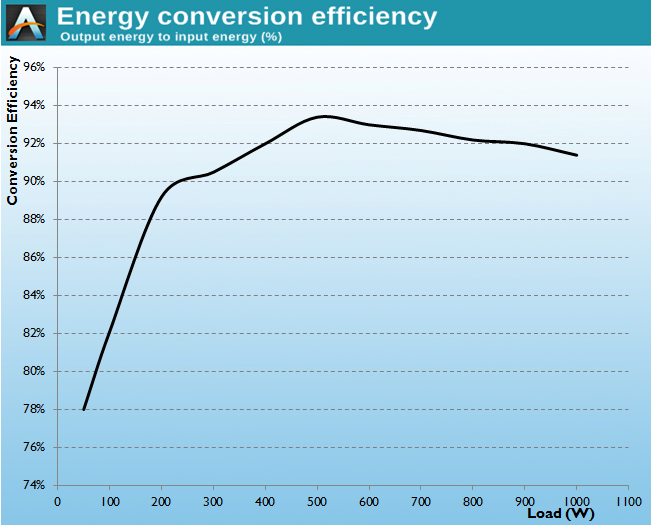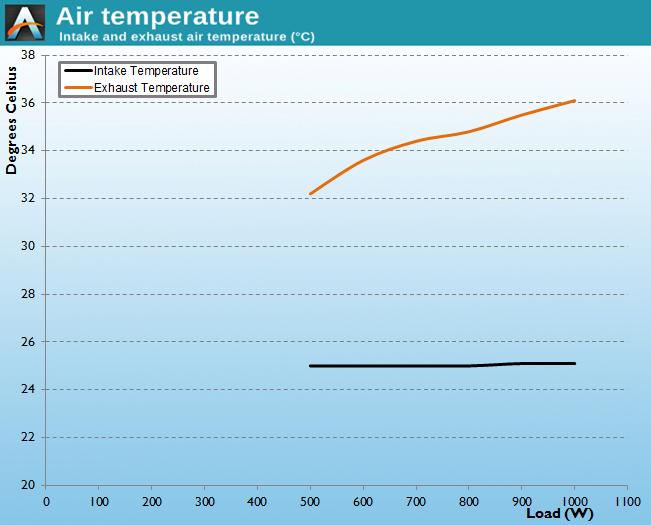Corsair RM1000 Power Supply Review
by E. Fylladitakis on April 24, 2014 6:00 AM EST- Posted in
- Cases/Cooling/PSUs
- Corsair
- PSUs
- RM Series
Cold Test Results
For the testing of PSUs, we are using high precision electronic loads with a maximum power draw of 2700W, a Rigol DS5042M 40MHz oscilloscope, an Extech 380803 power analyzer, two high precision UNI-T UT-325 digital thermometers, an Extech HD600 SPL meter, a self-designed hotbox, and various other bits and parts. For a thorough explanation of our testing methodology and more details on our equipment, please refer to our How We Test PSUs - 2014 article.
The Corsair RM1000 performs very well at room temperature, easily surpassing the 80Plus Gold Certification limits and reaching a maximum efficiency of 93.4% at 50% load. The average efficiency of the RM1000 within the nominal load range (20% to 100%) is 91.8%, which is an astonishing figure. When the load is reduced down to 50W, the efficiency drops down to 78%; however, although that may sound like a poor result, we should clarify that this actually is a very good figure and rarely can a PSU maintain an efficiency this high at just 5% load. However, such a low load is considered an "out of range" condition and does not affect the 80Plus certification, which takes into account only the 20% to 100% nominal capacity range.
There are no exhaust air temperature or noise measurements below 50% load because the fan does not spin until we reach 500W. The RM1000 is virtually inaudible while operating at room temperature, even when heavily stressed. Due to the passive cooling profile and the small heatsinks, however, the RM1000 tends to run warm, with the temperature of the tiny secondary side heatsinks floating around 55 °C and reaching up to 59.7 °C.















55 Comments
View All Comments
tynopik - Thursday, April 24, 2014 - link
where's the cart with cable lengths and connector spacings?poohbear - Thursday, April 24, 2014 - link
so, in 2014, what kind of system actually needs 1k wts? CPUs and Graphics cards are as power efficient as ever, so what are people doing with these 1k psus? My GTX 670s in SLI pull 300wts together under load, the newer graphics cards are even more power efficient, so what gives?peterfares - Friday, April 25, 2014 - link
mining coinsmeacupla - Saturday, April 26, 2014 - link
You're not supposed to load it up fully, because efficiency drops off.Generally, what you want to do is load up the PSU so that it's operating near peak efficiency where the computer is going full tilt. If you run an overclocked i7 and a pair of 780 cards, I think that gets you into the 600W range, or 60% load for this PSU, which is around the peak efficiency for it.
Antronman - Saturday, April 26, 2014 - link
2-way water OC SLI/CF with high-end cards+ CPU OC on water.600-700w power draw easily, and then another 80w+ for the monitor, plus 10w for each USB device.
ba-bam, you need a 1000w PSU.
royalcrown - Monday, April 28, 2014 - link
Except the monitors don't run off the psu ;)tabascosauz - Friday, April 25, 2014 - link
I had hoped that the higher wattage RMs (850W and now 1000W) would trade CapXon/TAICON/Teapo caps for Chemicon/Rubycon ones and the zero rpm fan profile for an even quieter fan, but I guess one can't always get what he wishes for.The thing is, at this price range there's just so much competition. You have absolutely stunning 80+ Gold and Platinum 1KW+ platforms from Super Flower, Seasonic, and Delta that don't miss a beat when it comes to high quality components and impeccable solder jobs. This makes the RM a lot less attractive (well, it does look nice on the outside but most other KW+ units also look nice).
YoloPascual - Friday, April 25, 2014 - link
^+1This psu has a zero rpm mode. The heat will f**k up those capxon and taicon. RM1000w is $190 now in newegg, EVGA G2 1000w $200 , Cooler Master V1000w $210.
Those who got more than 2 gpus will not bother to expend 10-20$ more if they can a much better psu. IF those people know more, not just brand names.
jonnyGURU - Friday, April 25, 2014 - link
I disagree. Not only are these caps rated at 105°C, but the temperatures inside the PSU don't get anywhere near that. Remember that the life of the cap increases exponentially the cooler it is from it's max rating.Also, Japanese caps are quite over-rated. They're not even made in Japan anymore (they're just Japanese brand) and the Chinese are using the same Japanese electrolyte and aluminum that the Japanese brands are using.
tabascosauz - Friday, April 25, 2014 - link
Well, manufacturers can obviously RATE their caps at the temperature they want them to be rated, but not all of them will deliver. Teapo has been in the game for quite a bit of time and now it's pretty much agreed that they are capable of delivering on the same level as the Japanese ones, but it's the TAICON and CapXon ones that are a little less sure.I do agree that even with a zero rpm fan mode, there's still a pretty capable fan on the RM. That's the reason why I would never buy a Seasonic fanless PSU for any reason. I must say that I haven't seen many 1000+ units from CWT and don't know how they fare (from the soldering jobs that they do I would say that CWT needs some more experience in the high end market, although it shouldn't really affect performance), Seasonic, Delta and to a certain extent Super Flower can claim their superiority here.
Are you OklahomaWolf or are you just a fan of jonnyGURU? That site is one of my go-to places for an education on PSUs, aside from TPU. All the others are pretty much junk.